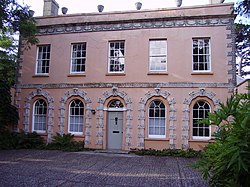
Back Pedra de Coade Catalan Coade-Stein German Piedra de Coade Spanish Pierre de Coade French Pietra di Coade Italian


Originally paired with the "South Bank Lion" at the Lion Brewery on the Lambeth bank of the River Thames.
(See "Twickenham Stadium Lion" below)

(See "Nelson Pediment" section below)

(See "Belmont House" section below)

Westminster Bridge, 1799.
(See adjacent "Coade and Sealy gallery section")
Coade stone or Lithodipyra or Lithodipra (Ancient Greek: λίθος/δίς/πυρά, lit. 'stone fired twice') is stoneware that was often described as an artificial stone in the late 18th and early 19th centuries. It was used for moulding neoclassical statues, architectural decorations and garden ornaments of the highest quality that remain virtually weatherproof today.
Coade stone features were produced by appointment to George III and the Prince Regent for St George's Chapel, Windsor; The Royal Pavilion, Brighton; Carlton House, London; the Royal Naval College, Greenwich; and refurbishment of Buckingham Palace in the 1820s.[1][2]
Coade stone was prized by the most important architects such as: John Nash-Buckingham Palace; Sir John Soane-Bank of England; Robert Adam-Kenwood House; and James Wyatt-Radcliffe Observatory.[3]
The product (originally known as Lithodipyra) was created around 1770 by Eleanor Coade, who ran Coade's Artificial Stone Manufactory, Coade and Sealy, and Coade in Lambeth, London, from 1769 until her death in 1821.[1] It continued to be manufactured by her last business partner, William Croggon, until 1833.[1][4]
- ^ a b c Alison Kelly (art historian) (2004). "Eleanor Coade". Oxford Dictionary of National Biography (online ed.). Oxford University Press. doi:10.1093/ref:odnb/37296. (Subscription or UK public library membership required.)
- ^ "Addidi Inspiration Award for Female Entrepreneurs - Eleanor Coade". addidi.com. Archived from the original on 25 April 2012. Retrieved 1 November 2011.
- ^ Cite error: The named reference
Birkbeck 1was invoked but never defined (see the help page). - ^ Roberts, Howard; Godfrey, Walter H. "Coade's Artificial Stone Works". Victoria County History. Vol. 23: Lambeth: South Bank and Vauxhall.
© MMXXIII Rich X Search. We shall prevail. All rights reserved. Rich X Search